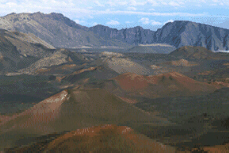
 |
     |
Within the Irons House is a recently renovated prison, dated circa 1852, that used to house unruly whalers and Hawaiians who broke the missionaries' strict codes of behavior; the building is located at the intersection of Prison and Wainee streets. One block north is the Baldwin House, Lahaina's oldest building. Constructed in 1834, the historic dwelling is an antique lover's paradise, stocked with a host of 19th-century paraphernalia.
The largest banyan tree in the U.S. is rooted in the center of town, across the street from a turn-of-the-century Victorian inn. One of Lahaina's most popular attractions, this sprawling, fantastically shaped tree is large enough to provide sufficient shade for up to 500 people. Also of interest are nearby Lahaina Whaling Museum, with its displays highlighting the whaling era; Wo Hing Temple, built by Chinese plantation workers; the old fort; and the Omni Theater, which has daily 3-D viewings of "The Hawaii Experience" on a domed screen.
The town's two championship 18-hole golf courses, numerous tennis courts, and oceanfront open-air shopping center offer visitors a bundle of diversions, although many vacationers are satisfied just lying on the sugary-white beaches absorbing the Hawaiian sun. The Lahaina-Kaanapali and Pacific Rail Road, also known as the Sugarcane Train, provides transportation between the two resort towns.
Not to be missed along the way are the Keanae Arboretum, Puaa Kaa State Park, Paia--an artsy windsurfing community that is home to the Manto Kuji Soto Buddhist Temple--and the Waianapanapa State Park, where you must walk through a lava tube to reach a phenomenal black-sand beach. If you plan to return to the eastern resort areas on the same day, it's a good idea to start out early so you don't have to drive back in the dark.
Just a stone's throw outside Hana lies the magnificent Piilanihale Heiau. Accepted to be Hawaii's largest temple, the 415-foot by 340-foot cliffside structure dates to the year1400. Also located just out of town near the foot of Haleakala Crater are the brown-sand Hana Beach Park and the magical Seven Sacred Pools--a series of ice-cold springs connected by waterfalls.
This region of verdant pastures and rolling hills is home to the Tedeschi Vineyard, Hawaii's only winery. In addition to the traditional red and white varieties, a special type of pineapple wine is also made on the 20-acre property, where a historic jailhouse has been converted into a wine-making facility.
The upcountry town of Makawao is another interesting stopping point. Working ranches are the heart of this old-west community, where a yearly Fouth-of-July rodeo highlights the daring feats of paniolos, or Hawaiian cowboys. The eclectic town embodies an interesting marriage of Old-West and New-Age sensibilities, boasting numerous art galleries, a holistic pharmacy, and the Maui School of Yoga Therapy.
Undoubtedly, the best time to visit Haleakala is early morning, before the warm air pushes clouds up into the crater. Try to arrive before sunrise, so that you can witness the dawn sky gently unfurl its dazzling palate of colors, which range from the softest rose to deep vermilion. The Haleakala Visitors' Center has maps for hiking enthusiasts, but probably the most popular way to experience the crater is on mountain bike, and most tour operators in the resort areas offer this adventure. Every morning vans bring dozens of tourists and bikes to the top of Haleakala. They don bright yellow slickers in case of rain, and follow a guide slowly down the mountain. Remember, temperatures here are usually 30 degrees lower than at sea level, so bring a warm layer of clothes.
|
|
© 2000-2009 Waikiki.com. All Rights Reserved.